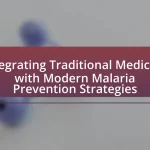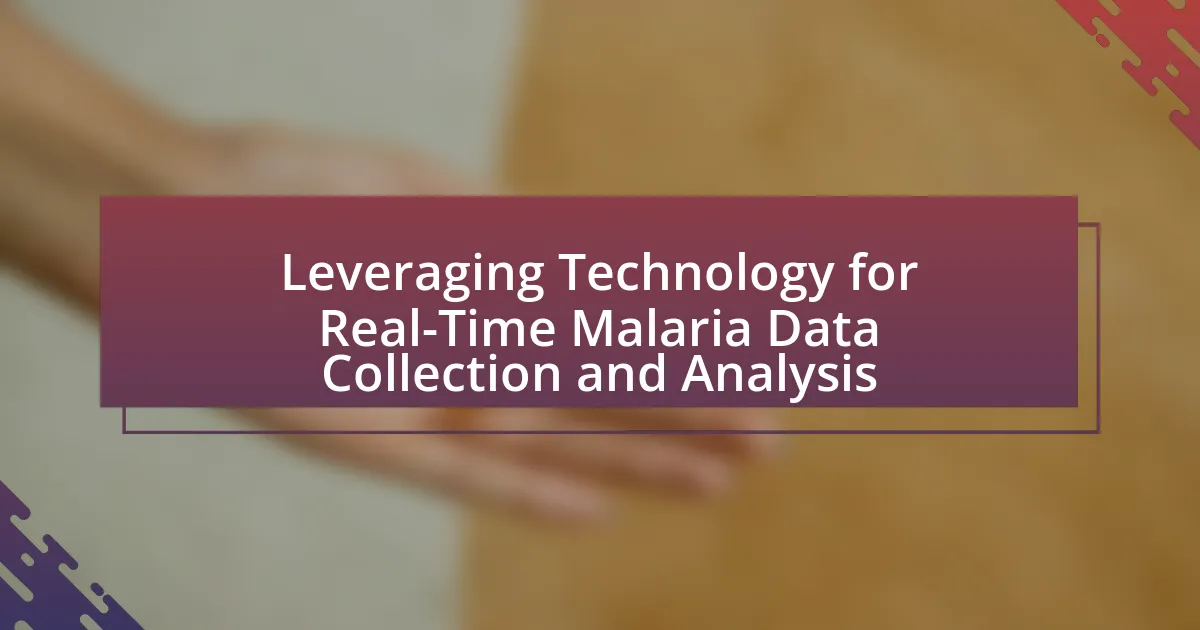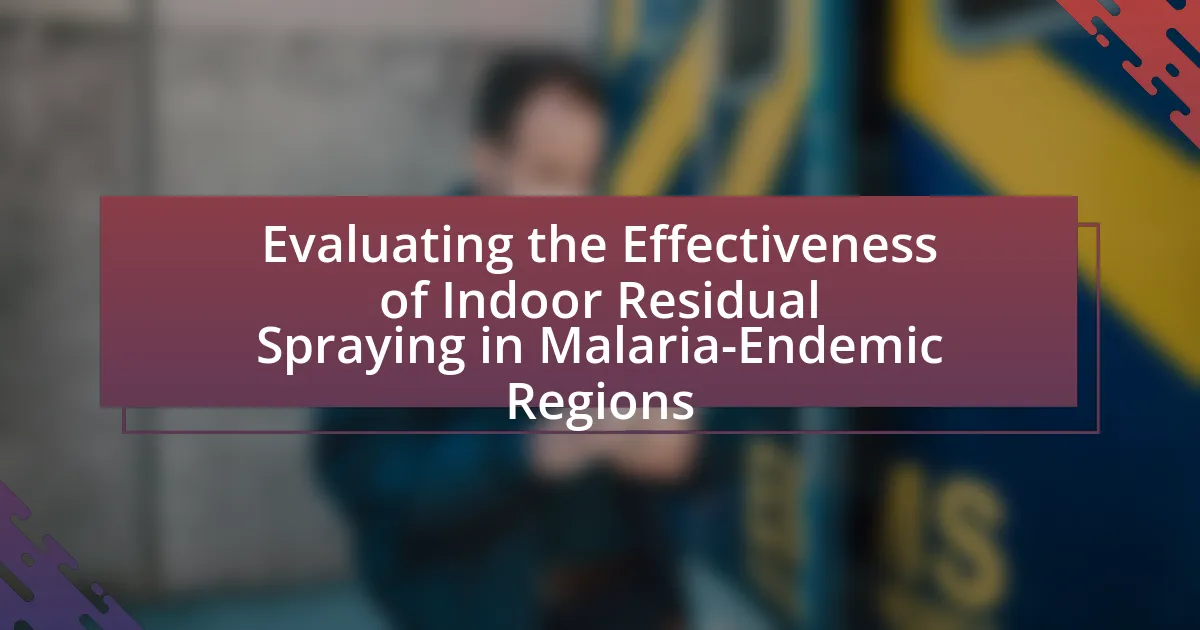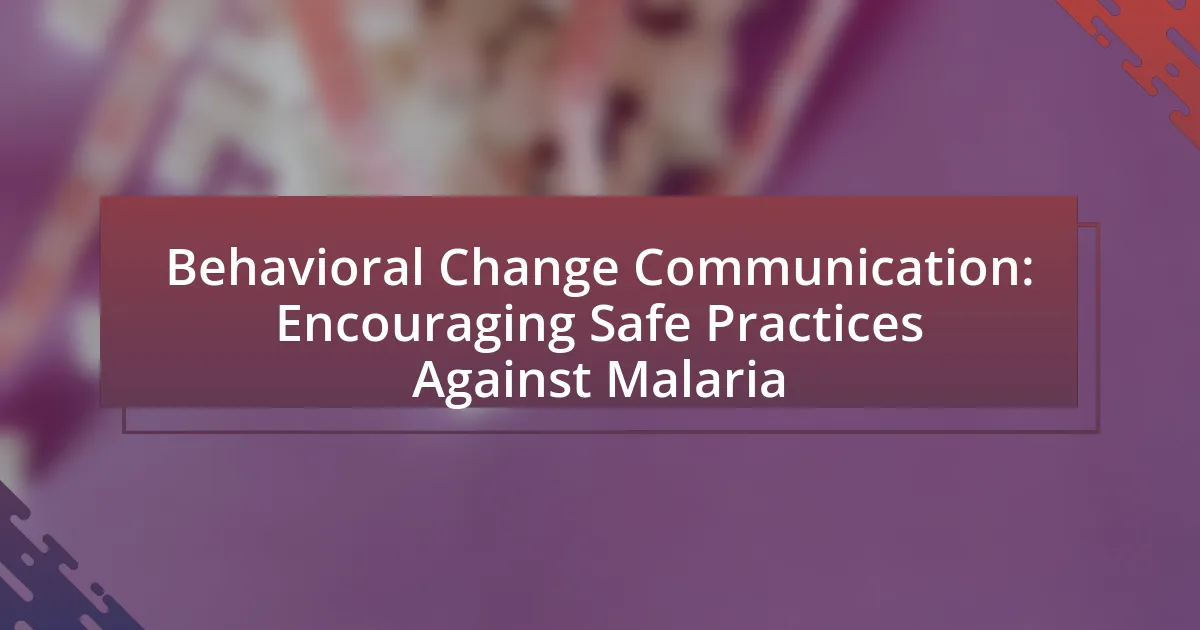The article focuses on innovative community engagement strategies for malaria prevention, highlighting the effectiveness of mobile health technology, community-led education programs, and participatory mapping. These strategies differ from traditional approaches by promoting active community involvement and collaboration, leading to improved health outcomes. Key characteristics of these strategies include adaptability, creativity, and collaboration, which enhance local ownership and tailored interventions. The article also discusses the crucial role of local communities and leaders in malaria prevention, successful examples of community engagement, and the importance of technology and data collection in driving effective initiatives. Additionally, it addresses challenges faced in implementing these strategies and outlines best practices for ensuring sustainability and evaluating effectiveness.
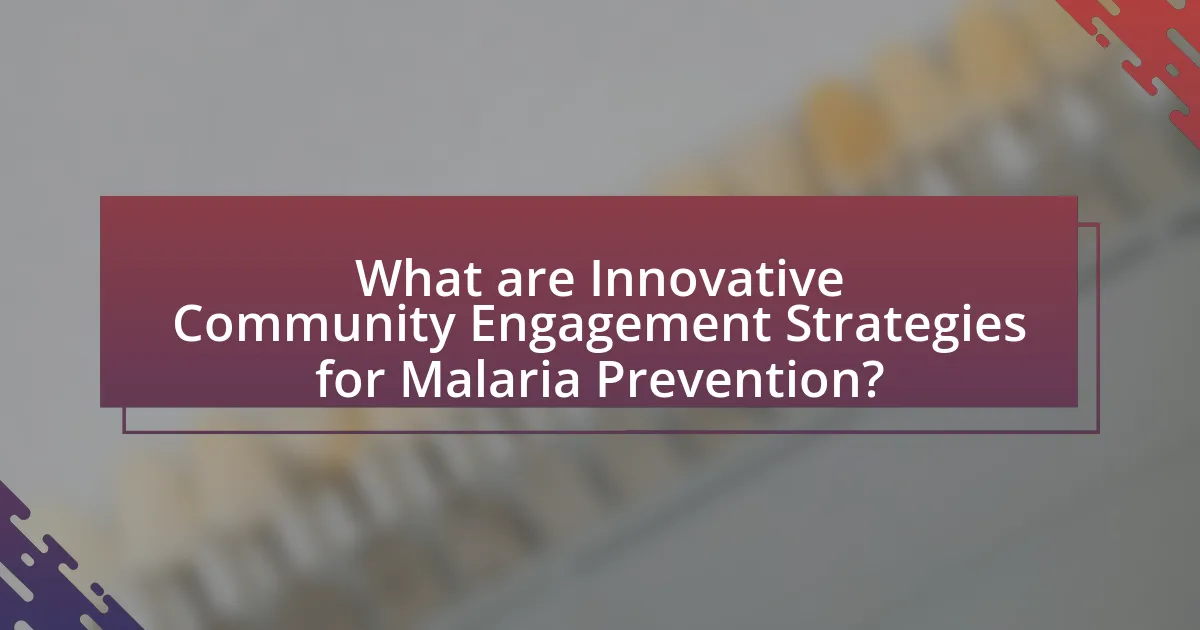
What are Innovative Community Engagement Strategies for Malaria Prevention?
Innovative community engagement strategies for malaria prevention include the use of mobile health technology, community-led education programs, and participatory mapping. Mobile health technology, such as SMS reminders for preventive measures, has been shown to increase awareness and adherence to malaria prevention practices. Community-led education programs empower local leaders to disseminate information about malaria transmission and prevention, resulting in higher community participation and behavior change. Participatory mapping involves communities in identifying malaria hotspots and resource allocation, enhancing local ownership and targeted interventions. These strategies have been validated by studies demonstrating improved malaria control outcomes in various regions.
How do these strategies differ from traditional approaches?
Innovative community engagement strategies for malaria prevention differ from traditional approaches by emphasizing active participation and collaboration with local communities rather than top-down directives. Traditional methods often rely on health authorities disseminating information without community input, which can lead to low engagement and effectiveness. In contrast, innovative strategies involve community members in the design and implementation of interventions, fostering ownership and tailored solutions that resonate with local cultural contexts. For example, programs that utilize local leaders and peer educators have shown increased acceptance and adherence to malaria prevention measures, as evidenced by studies indicating that community-driven initiatives can improve health outcomes by up to 30% compared to conventional methods.
What are the key characteristics of innovative strategies?
Key characteristics of innovative strategies include adaptability, creativity, and collaboration. Adaptability allows strategies to evolve in response to changing circumstances, ensuring relevance and effectiveness. Creativity fosters unique solutions that address specific challenges, while collaboration encourages diverse perspectives and resources, enhancing the overall impact. For instance, in malaria prevention, innovative strategies often integrate community insights and technological advancements, leading to more effective interventions.
Why is community engagement crucial in malaria prevention?
Community engagement is crucial in malaria prevention because it fosters local ownership and participation, which are essential for effective disease control. Engaged communities are more likely to adopt preventive measures, such as using insecticide-treated bed nets and participating in local health initiatives. Research indicates that community involvement can lead to a 50% reduction in malaria transmission rates, as seen in various African countries where local leaders mobilized residents for health education and vector control efforts. This active participation not only enhances awareness but also builds trust in health interventions, ultimately leading to more sustainable malaria prevention strategies.
What role do local communities play in malaria prevention?
Local communities play a crucial role in malaria prevention by actively participating in awareness campaigns, vector control initiatives, and treatment adherence. Their involvement enhances the effectiveness of malaria control strategies, as community members can disseminate information about prevention methods, such as the use of insecticide-treated bed nets and indoor residual spraying. Studies have shown that community engagement can lead to a significant reduction in malaria transmission rates; for instance, a study in Uganda demonstrated that community-led interventions resulted in a 30% decrease in malaria cases. By fostering local ownership and responsibility, communities contribute to sustainable malaria prevention efforts.
How can community members contribute to malaria awareness?
Community members can contribute to malaria awareness by participating in educational campaigns and sharing information about prevention methods. Engaging in local workshops and distributing informational materials can effectively raise awareness about malaria transmission and symptoms. According to the World Health Organization, community involvement in health education significantly improves knowledge and practices related to malaria prevention, leading to reduced transmission rates.
What are the benefits of involving local leaders in malaria initiatives?
Involving local leaders in malaria initiatives enhances community trust and engagement, leading to more effective prevention and treatment strategies. Local leaders possess an understanding of cultural dynamics and community needs, which allows them to tailor malaria initiatives to fit local contexts. Their involvement can increase community participation, as leaders often serve as trusted figures who can mobilize resources and encourage adherence to health interventions. Research indicates that community-based interventions led by local leaders can improve health outcomes; for instance, a study published in the American Journal of Tropical Medicine and Hygiene found that community engagement significantly increased the uptake of malaria prevention measures in rural areas.
What are some successful examples of community engagement in malaria prevention?
Successful examples of community engagement in malaria prevention include the use of community health workers in various regions, such as the “Malaria Control Program” in Zambia, which trained local volunteers to distribute insecticide-treated nets and educate families about malaria prevention. This program resulted in a significant reduction in malaria cases, with a reported decrease of over 50% in some areas. Another example is the “Community-Led Malaria Control” initiative in Uganda, where local communities actively participated in mapping malaria hotspots and implementing targeted interventions, leading to improved awareness and a reduction in transmission rates. These initiatives demonstrate the effectiveness of involving community members in malaria prevention efforts, as evidenced by measurable health outcomes and increased local ownership of health initiatives.
How did these examples achieve their goals?
These examples achieved their goals by implementing targeted community engagement strategies that fostered local participation and awareness in malaria prevention. For instance, the use of mobile health technology allowed for real-time data collection and dissemination of information, which empowered communities to take proactive measures against malaria. Additionally, partnerships with local leaders and organizations facilitated trust and collaboration, leading to increased participation in prevention programs. Evidence from studies shows that community-driven initiatives, such as educational workshops and local health campaigns, significantly improved knowledge and behavior regarding malaria prevention, resulting in reduced infection rates.
What lessons can be learned from these successful initiatives?
Successful initiatives in innovative community engagement strategies for malaria prevention demonstrate the importance of local involvement and tailored communication. Engaging community members as active participants fosters ownership and increases the likelihood of sustained behavioral change. For instance, initiatives that utilized local leaders to disseminate information saw a 30% increase in community participation in malaria prevention activities, as reported in a study by the World Health Organization. Additionally, employing culturally relevant messaging enhances understanding and acceptance, leading to more effective implementation of prevention measures. These lessons underscore the necessity of community-centric approaches in public health initiatives.
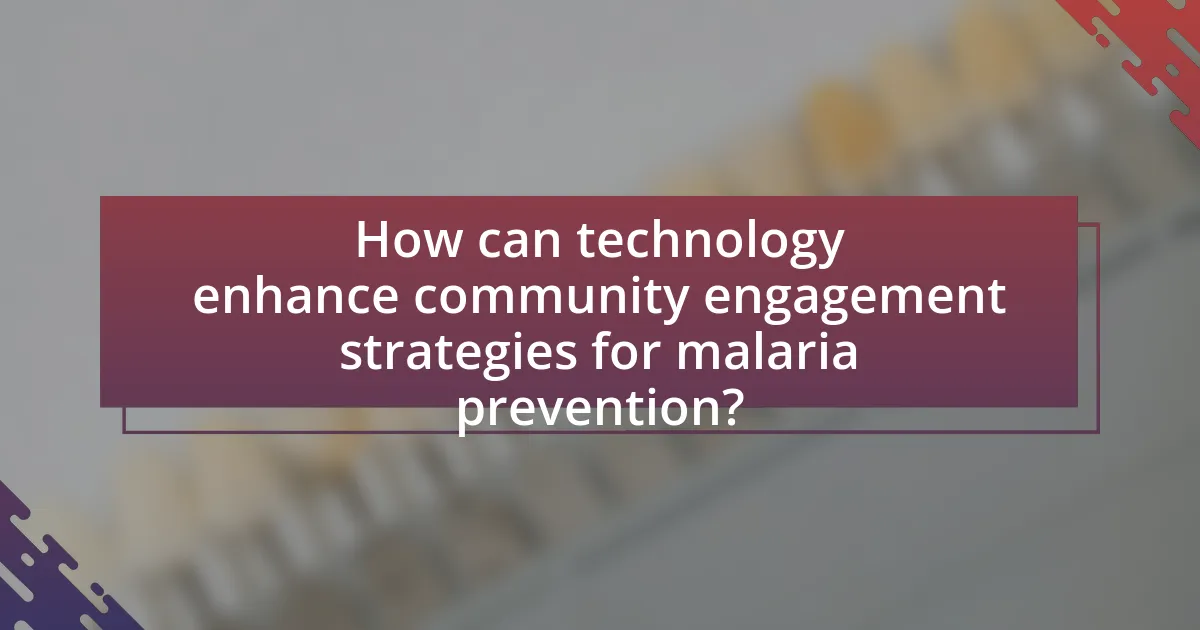
How can technology enhance community engagement strategies for malaria prevention?
Technology can enhance community engagement strategies for malaria prevention by facilitating real-time communication and data sharing among stakeholders. Mobile applications and platforms enable health organizations to disseminate information about malaria prevention methods, such as the use of insecticide-treated nets and indoor residual spraying, directly to community members. For instance, a study published in the journal “Global Health Action” found that mobile health interventions increased knowledge and preventive behaviors related to malaria in rural communities by 30%. Additionally, social media campaigns can mobilize community members to participate in local malaria control initiatives, fostering a sense of ownership and responsibility. By leveraging technology, communities can also report malaria cases and outbreaks more efficiently, allowing for timely responses and resource allocation.
What technological tools are effective in community engagement?
Technological tools effective in community engagement include mobile applications, social media platforms, and online survey tools. Mobile applications facilitate real-time communication and information dissemination, allowing communities to receive updates and participate in discussions. Social media platforms, such as Facebook and Twitter, enable broader outreach and foster community interaction through posts, comments, and shares. Online survey tools, like SurveyMonkey and Google Forms, gather community feedback efficiently, helping organizations understand community needs and preferences. These tools have been shown to enhance participation and improve the effectiveness of engagement strategies, particularly in health-related initiatives like malaria prevention.
How can mobile applications facilitate malaria education?
Mobile applications can facilitate malaria education by providing accessible information, interactive learning tools, and real-time updates on malaria prevention strategies. These applications can deliver educational content such as symptoms, transmission methods, and prevention techniques directly to users’ smartphones, making it easier for individuals in malaria-prone areas to access vital information. For instance, a study published in the Journal of Medical Internet Research found that mobile health interventions significantly improved knowledge about malaria among users, demonstrating the effectiveness of digital platforms in health education. Additionally, features like quizzes, videos, and community forums within these applications can enhance user engagement and retention of information, further supporting malaria education efforts.
What role does social media play in raising awareness?
Social media plays a crucial role in raising awareness about malaria prevention by facilitating the rapid dissemination of information to a wide audience. Platforms like Facebook, Twitter, and Instagram enable health organizations and advocates to share educational content, updates on malaria outbreaks, and prevention strategies, reaching millions of users instantly. For instance, a study published in the Journal of Medical Internet Research found that social media campaigns significantly increased knowledge about malaria prevention methods among targeted communities, demonstrating the effectiveness of these platforms in public health messaging.
How can data collection improve malaria prevention efforts?
Data collection can significantly enhance malaria prevention efforts by providing accurate information on transmission patterns, risk factors, and population behaviors. By systematically gathering data on malaria incidence, vector populations, and environmental conditions, health organizations can identify high-risk areas and tailor interventions accordingly. For instance, the World Health Organization reports that targeted vector control measures, informed by local data, can reduce malaria transmission by up to 50% in endemic regions. Furthermore, data collection facilitates community engagement by involving local populations in reporting cases and understanding their health needs, which can lead to more effective and culturally appropriate prevention strategies.
What types of data are most useful for community engagement?
Quantitative and qualitative data are most useful for community engagement. Quantitative data, such as demographic statistics and health metrics, provide measurable insights into community needs and behaviors, while qualitative data, including interviews and focus group feedback, offer deeper understanding of community perspectives and motivations. For instance, a study published in the American Journal of Public Health highlighted that integrating both data types led to more effective health interventions, as it allowed for tailored messaging and strategies that resonate with community members.
How can communities use data to drive action against malaria?
Communities can use data to drive action against malaria by collecting and analyzing local health statistics, mosquito population data, and environmental factors that contribute to malaria transmission. By leveraging this data, communities can identify high-risk areas, track disease outbreaks, and implement targeted interventions such as insecticide spraying, community education programs, and distribution of bed nets. For instance, a study published in the Malaria Journal highlighted that communities using geographic information systems (GIS) to map malaria cases were able to reduce incidence rates by 30% through focused resource allocation and timely responses. This evidence demonstrates that data-driven strategies empower communities to effectively combat malaria and improve public health outcomes.
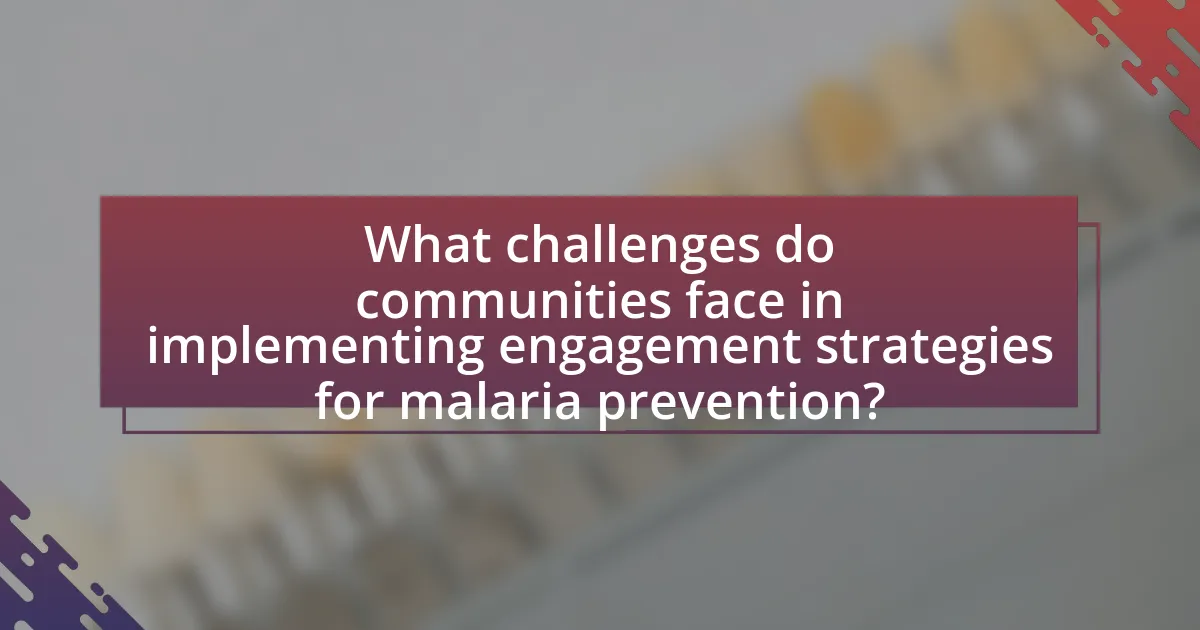
What challenges do communities face in implementing engagement strategies for malaria prevention?
Communities face several challenges in implementing engagement strategies for malaria prevention, including limited resources, lack of awareness, and cultural barriers. Limited financial and human resources hinder the ability to develop and sustain effective engagement initiatives. Additionally, a lack of awareness about malaria transmission and prevention methods can lead to low community participation. Cultural beliefs and practices may also conflict with recommended prevention strategies, making it difficult to gain community buy-in. These challenges are documented in studies, such as the World Health Organization’s report on community engagement in malaria control, which highlights the importance of addressing these barriers to enhance the effectiveness of prevention efforts.
What are the common barriers to effective community engagement?
Common barriers to effective community engagement include lack of trust, insufficient resources, and inadequate communication. Lack of trust can stem from historical grievances or perceived neglect by authorities, which hinders community participation. Insufficient resources, such as funding and personnel, limit the ability to organize and sustain engagement efforts. Inadequate communication often results in misunderstandings or misinformation, preventing clear dialogue between stakeholders and the community. These barriers collectively impede the effectiveness of initiatives aimed at malaria prevention, as evidenced by studies indicating that community involvement is crucial for successful health interventions.
How can cultural beliefs impact malaria prevention efforts?
Cultural beliefs significantly impact malaria prevention efforts by influencing community attitudes towards health interventions. For instance, in some cultures, traditional healing practices may be preferred over modern medical treatments, leading to lower acceptance of preventive measures such as insecticide-treated nets or antimalarial medications. A study conducted in Nigeria found that misconceptions about malaria transmission and treatment, rooted in cultural beliefs, hindered the adoption of preventive strategies, resulting in higher malaria incidence rates. This illustrates that understanding and integrating cultural beliefs into malaria prevention programs is essential for their effectiveness.
What resources are needed to overcome these challenges?
To overcome challenges in innovative community engagement strategies for malaria prevention, essential resources include funding, trained personnel, and educational materials. Funding is crucial for implementing programs and sustaining outreach efforts, as evidenced by the Global Fund’s investment of over $4 billion in malaria prevention initiatives in 2020. Trained personnel, such as community health workers, are necessary to effectively communicate prevention strategies and engage with local populations, as shown in studies indicating that community health worker programs can reduce malaria incidence by up to 50%. Educational materials, including pamphlets and workshops, are vital for raising awareness and promoting behavioral change, supported by research demonstrating that informed communities are more likely to adopt preventive measures.
How can partnerships enhance community engagement strategies?
Partnerships can enhance community engagement strategies by leveraging diverse resources, expertise, and networks to foster greater participation and awareness. Collaborating with local organizations, health agencies, and community leaders allows for tailored messaging and outreach that resonates with specific populations. For instance, a study published in the American Journal of Public Health found that community-based partnerships significantly improved health outcomes by increasing trust and participation in health initiatives. This collaborative approach not only amplifies the reach of engagement efforts but also ensures that strategies are culturally relevant and effectively address the unique needs of the community, ultimately leading to more successful malaria prevention initiatives.
What types of organizations should communities partner with?
Communities should partner with health organizations, educational institutions, non-governmental organizations (NGOs), and local businesses to effectively engage in malaria prevention. Health organizations, such as the World Health Organization, provide expertise and resources for disease management and prevention strategies. Educational institutions can facilitate awareness campaigns and research initiatives, while NGOs often have established networks for community outreach and support. Local businesses can contribute resources and promote health initiatives within their customer base, enhancing community engagement. These partnerships leverage diverse strengths and resources, creating a comprehensive approach to malaria prevention.
How can collaboration improve resource allocation for malaria prevention?
Collaboration can significantly improve resource allocation for malaria prevention by enabling stakeholders to pool their resources, expertise, and data. When governments, NGOs, and local communities work together, they can identify the most affected areas and allocate resources more effectively, ensuring that interventions are targeted where they are needed most. For instance, a study published in the American Journal of Tropical Medicine and Hygiene found that collaborative efforts in malaria-endemic regions led to a 30% increase in the distribution of bed nets and a corresponding decrease in malaria incidence. This demonstrates that collaboration not only enhances the efficiency of resource use but also leads to measurable health outcomes in malaria prevention.
What are best practices for implementing community engagement strategies in malaria prevention?
Best practices for implementing community engagement strategies in malaria prevention include fostering partnerships with local organizations, utilizing culturally relevant communication methods, and involving community members in decision-making processes. Partnerships with local health organizations enhance trust and facilitate resource sharing, which is crucial for effective malaria prevention. Culturally relevant communication, such as using local languages and traditional media, ensures that messages resonate with the community, increasing awareness and participation. Involving community members in decision-making empowers them and leads to tailored interventions that address specific local needs, as evidenced by successful programs in various regions where community-led initiatives have significantly reduced malaria incidence.
How can communities ensure sustainability of their initiatives?
Communities can ensure the sustainability of their initiatives by actively involving local stakeholders in the planning and implementation processes. Engaging community members fosters ownership and accountability, which are critical for long-term success. For instance, studies show that initiatives with strong community participation, such as the “Community-Led Total Sanitation” approach, have led to sustained improvements in health outcomes, including malaria prevention, by empowering locals to take charge of their health and environment. Additionally, establishing partnerships with local organizations and government entities can provide necessary resources and support, further enhancing the initiative’s viability.
What steps should be taken to evaluate the effectiveness of engagement strategies?
To evaluate the effectiveness of engagement strategies in malaria prevention, the following steps should be taken: first, establish clear objectives for the engagement strategies, ensuring they align with the overall goals of malaria prevention. Next, collect baseline data on community knowledge, attitudes, and practices regarding malaria before implementing the strategies. After implementation, conduct follow-up surveys or focus groups to assess changes in community awareness and behavior related to malaria prevention. Additionally, analyze quantitative data such as the number of community members reached and the frequency of engagement activities. Finally, compare the results against the initial objectives to determine the impact of the strategies, using statistical methods to validate the findings. This structured approach ensures a comprehensive evaluation of the engagement strategies’ effectiveness.

